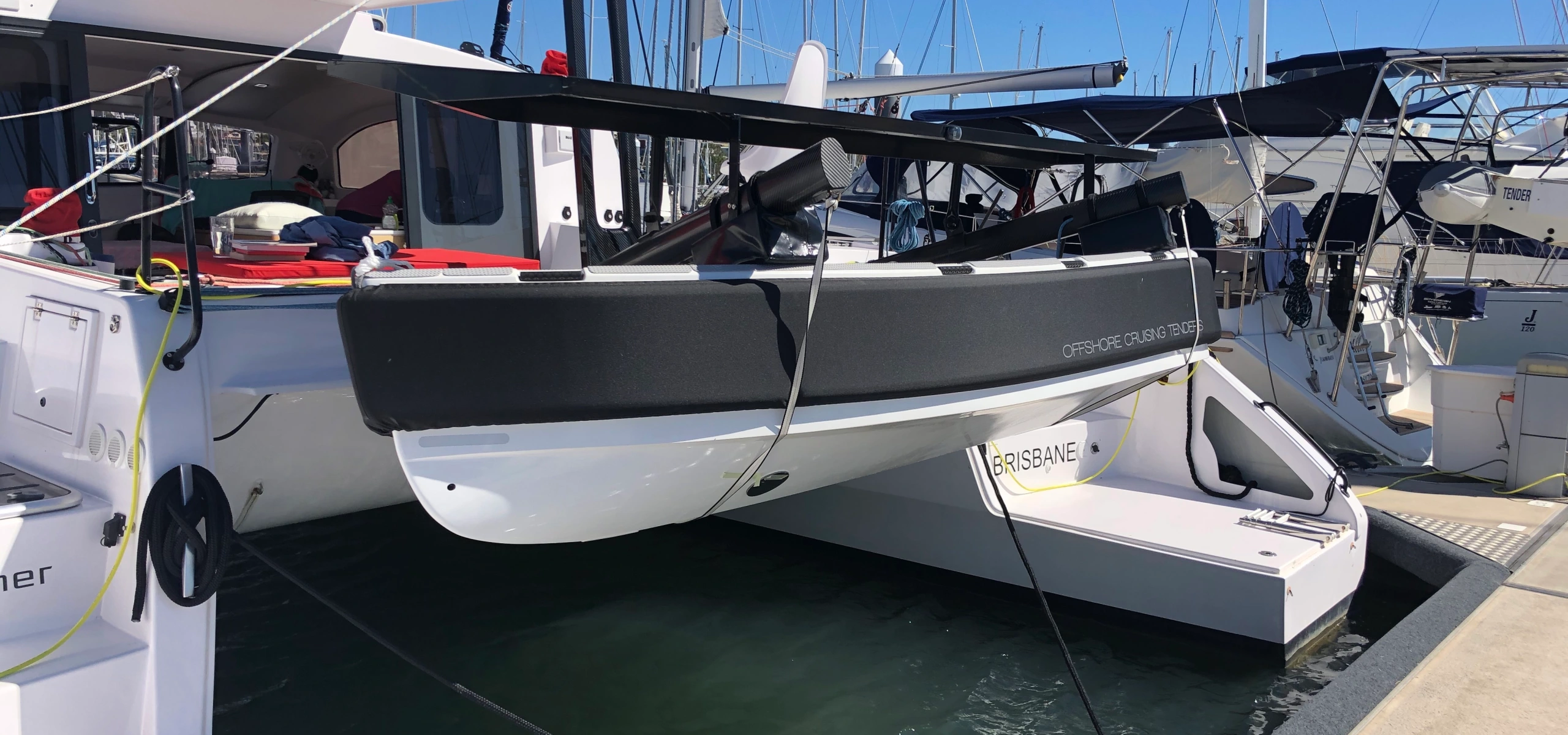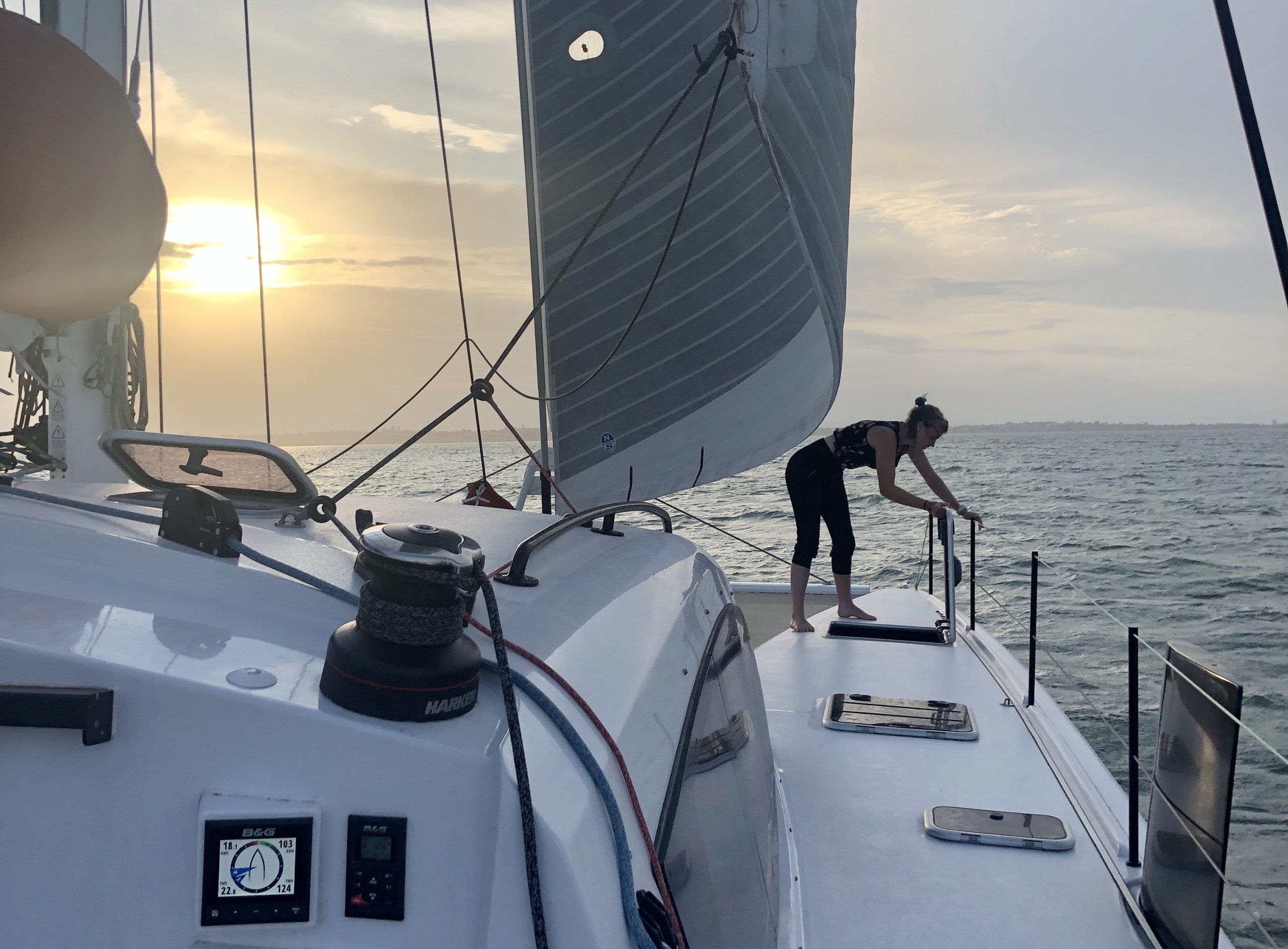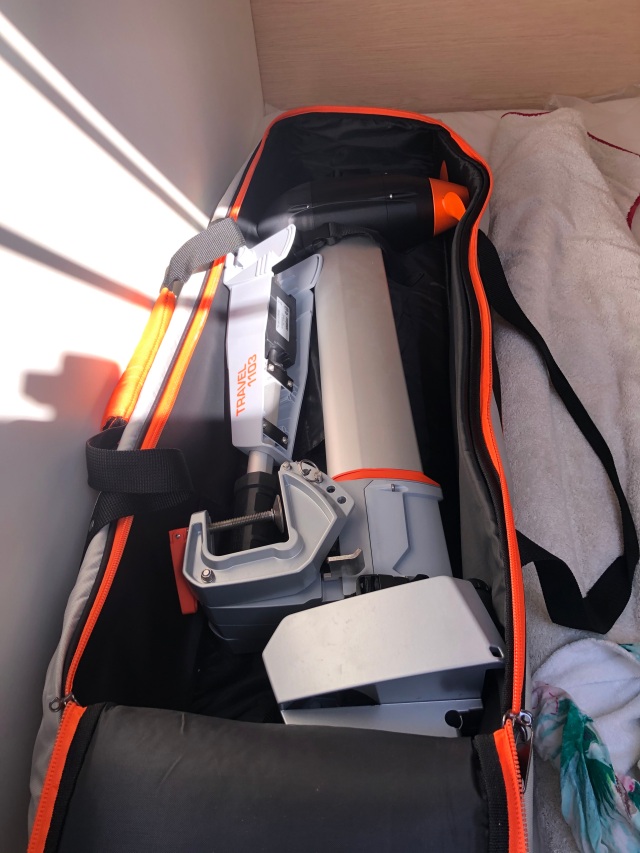What we think of our OC Tender and Torqeedo electric outboard

I explained in an earlier post that we were purchasing a carbon fiber, rigid (non-inflatable) tender for Puffin. Our tender is made by Offshore Cruising Tenders in New Zealand, and it’s an exceptionally high quality and beautiful piece of craftsmanship. Our tender is the OC330 model and the hull weight in carbon is an amazingly low 39kg. Adding beach wheels and accessories pushes this up to around 50kg, which is still very light.
I initially thought we would go with a Torqeedo Travel electric outboard, but there was almost no information about how the Torqeedo would perform on a tender, and dropping down to 3hp equivalent power seemed just too restrictive, so I changed my mind and purchased a 6hp Yamaha four stroke outboard. This is still a very small outboard, considering our tender on Wildling, a 3.8m Highfield had a 20hp Honda engine. The 6 hp on our OC Tender has worked pretty well though, and with Robin and I onboard we can get on a plane, but it takes nearly full throttle to do it.
The problems with this setup are that the motor weighs 27kg plus another 15kg for the 5 gallon fuel tank, so it’s heavy. It’s also pretty large, and vibrates a lot and is very noisy when it’s working hard. The carbon tender doesn’t flex when bouncing into waves, so the ride can get uncomfortable when going fast. We find ourselves motoring below planing speed most of the time, which is comfortable and gets us around quite quickly.
This made me reconsider the Torqeedo electric outboard option. Since I’m mostly at half throttle on the 6hp Yamaha, maybe the 3hp Torqeedo would do the job? Another search yielded that there’s still almost no information available online about real-world application of the Torqeedo 1103C on a tender, so I decided to be the guinea pig and try it out.
The Torqeedo is very light. Only 17kg for the motor & drive unit including the lithium battery. In fact it’s so light that it’s no trouble at all to take off the tender and store inside the boat in its carry bag when not in use.
Our initial test runs have been quite good. The Torqeedo is able to push us along at 6-8 knots. There’s no way it will get us on a plane though, so we have to adjust our expectations of how we use our tender.
Pros and Cons of the OC Tender and Torqeedo
I would say this solution is really not for everyone. There are some compromises required when going for the lightest possible tender & motor setup. Based on our experience to date here are the points for and against this setup:
Pros:
- Very light, so no loss of performance of our Outremer 4X under sail
- Motor is easy to lift and lower and to fit and remove from the tender
- Very easy to lift the tender up and down off the davits
- No need to deal with fuel tanks, manual pull starting, maintenance and reliability issues of an outboard motor
- No noise and no smell, the motor is pretty much silent
- Motor can be easily taken off and stored in the main boat so more secure
- Battery can be recharged using a portable solar panel, providing renewable energy powered transport
- The OCTender is much drier than a RIB, this means traveling at less than planing speed is not uncomfortable. Often on A RIB you have to get on a plane to avoid getting soaked by the chop.
- Moving the tender around on the shore is very easy. Even for older folks the light weight and beach wheels makes this no problem. A huge benefit when dealing with large tides.
- For those that like stress-free cruising, taking it easy on the tender is more fun!
Cons:
- This is a low speed means of transport. People that like to zoom around in their tenders will probably find it too slow
- Motoring into steep waves and wind is slow. In these conditions, the lack of power from the Torqeedo could cause safely concerns
- Limited to short trips. The range is about 8km on a charge under normal use. This makes it better suited to short trips between the anchorage and shore, and not good for long exploration trips, although reducing speed and carrying an extra battery would boost range to around 20km.
- Have to wait for the battery to recharge after use. This can be solved with an extra battery so there is always a fully charged battery available.
- The OCTender is less stable and more weight sensitive than a RIB. This is not an issue when underway, but getting in and out requires more care than a RIB. The lack of soft tubes to sit on makes the ride less comfortable, but this can be improved by carrying some foam pads to use when climbing aboard and sitting on the sides.
Our conclusion
We’re getting older and our backs and knees aren’t what they used to be, so we’re not really interested in going fast in small tenders. This lightweight, electric setup is really good for us. We love the ease of use and portability of both the tender and the motor. It’s also very satisfying to know the tender is not a weight penalty when we are under sail. The only change we are making is that we are ordering an extra battery to give us some safety margin.








Hi Doug, thanks for this post.
We bought the same OC tender and Torqueedo but have to wait until March next year before our Outremer 45 is delivered. Your post confirms we made the right choice.
Cheers Rob
LikeLike
Hi Rob, I think the OC330 is the perfect tender for an Outremer 45, it fits perfectly on the davits and is so easy to lower and raise. It’s quite amazing that a tender this light can be so functional! I had to fiddle around with the position and length of the lifting lines both on the tender itself and on the davits. I’ll post a HOW TO guide for setting up the tender for lifting, as I learned a few tricks along the way.
LikeLike
Thanks, nice review. I looked at the Torqueedos at a boat show last year and the price knocked me. I expect this will only drop.
And good observation on living without planning. Can save a lot of power/ weight / money.
Thanks for sharing!
B
LikeLike
Thanks Doug We appreciate the effort you put into research and sharing the results – very helpful for us as we plan our boat. I’m very keen on an electric motor not only for low emissions but because it’s clean and can be stored inside the boat easily.
LikeLike
Thanks Jenni, the Torqeedo is so much better than a petrol/gasoline burning outboard in this regard. When we’re done cruising, I just detach the battery and control arm and then pull the drive leg out of the water and hand them up to Robin in the cockpit. Each component is light and easy to lift and move around. We rinse the drive leg with the transom shower and let it dry on the trampoline, while the battery recharges with the solar panel. When we’re living at anchor we leave the drive leg on, and detach the battery to recharge each day on the foredeck. The whole experience is so clean and easy that any reduction in speed that we experience is more than worth it. We rarely use our engines on Puffin, so we feel very green when living at anchor, it’s awesome!
LikeLike
Doug
That’s great to hear how the OC is such a great solution for you,all your points made ring a clear bell with me and show the extreme versatility of this incredibly well designed product.
My OC is the 3.5 with a Yamaha 15 hp 2 stroke , I surely do recognise the environment gap between our usage and I love to travel up to 20 miles across quite rough water at time’s to chase gamefish along tropical drop offs
There in lies the versatility and incredible performance of the OC , also I might add the product backing from Russell and Carin is second to none, they Are number one.
LikeLike
This is super useful and informative Doug, thank you so much for your time in sharing.
Kind Regards,
Karin Carlyon
Offshore Cruising Tenders
LikeLike
Doug- Love this setup and have been researching similar ideas. Did you go with the full carbon 330? Did you consider the larger 350? Curious, did you consider the Torqeedo Cruise 2.0T or 4.0T? Total weight is similar to your 6hp motor, but w/electric outboards 17kg-18kg, still easy to remove from the tender. Adding the separate 25kg-35kg battery on the floor thinking it would add some nice stability down low. Did OC Tenders or Torqeedo offer to specific Wh/speed/distance plots? I would expect there’s a sweet spot just slightly over initial planning speed.
Thanks for allowing us to all live vicariously through you!
Eric
LikeLike
Hi Eric, great questions!
– Yes, ours is the full carbon OC330, for our 4X keeping the weight low was an important design goal for all our equipment choices, including the tender.
– Because it’s mostly just Robin and I, we didn’t need the extra size of the 350, plus the 330 allows us to use a smaller outboard and it fits nicely on our davits.
– I did look at the cruise versions of the Torqeedo, but decided against them because of the weight (moving those batteries in and out of the boat, with a dodgy back is not workable for us), and they would take a lot more of our solar capacity to keep them charged. They are also very expensive!
– Torqeedo offers very little information about the actual performance of their motors. It would be very helpful if they would collaborate with tender manufactures to do some testing and publish results, I bet they would sell more motors, it’s an expensive leap of faith to go down this path without knowing the end result.
LikeLiked by 1 person
Can you fix the torqeedo yourself in out of the way places?
I also bought a Torqeedo and it stopped working and I can can get no response from the Australian importer.
I don’t think that they’re ready for serious cruisers. One of the instructions says that after use in salt water you should wash it down in fresh water every time! Who has that much fresh water available. I find that the plugs are way too fiddly for daily use – easy to cross thread the locking nuts.
It’s too complicated for real world use.
Much as I love the idea of an electric outboard, I won’t be recommending Torqeedo to anyone.
LikeLike
Hi Justin, I definitely can not fix a Torqeedo if it stops working. An unreliable outboard is a huge problem, and is an additional risk with new technology. I will report back on reliability over time. All OCTenders come with sturdy, full size wooden oars and rollicks, so in a worst case scenario we can row the boat quite quickly and easily. We don’t intend to travel too far from our main boat in the tender, so hopefully this gives us an option if we have a breakdown.
LikeLike
Two years ago I saw three dead Torqueedos next to the dumpster at Minn’s in Georgetown. Kent told me all three were replaced with Yamaha 15hp 2 strokes. Seemed ironic to me.
LikeLike
Two Winters past, at Minn’s in Georgetown, I noticed three Torqueedos propped up next to the dumpster. Kent explained that all three had failed and been replaced by Yamaha 15hp 2 strokes. Does this qualify as irony?
LikeLike
Hi Doug.
This is as informative as always.
Tracey and I are currently building an Outremer 55.
We are of course stuck in Sydney and if it’s ok can you give me your number so I can call. It would be much appreciated
LikeLike
I’d hazard a Torqeedo is probably less likely to be nicked….
LikeLike
Did you consider the Spirited Designs Ripple? Similar in weight to the OC. https://www.spiriteddesigns.com.au/ripple_tenders1
I like the idea of the OC, but really want something that can go long distances in chop to reach snorkel/diving spots. Looks like the flat bottom of the OC might pound a bit on plane.
What other options have you seen for a modest weight “expedition tender”?
LikeLike
3+ Year Update?
LikeLike